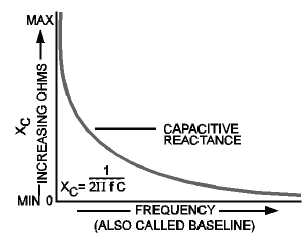1-45
RESULTANT REACTANCE X = (XL
-
X
C) or X = (XC
-
XL). XL is usually plotted above the
reference line and X
C
below the reference line. Inductance and capacitance have opposite effects on the
current in respect to the voltage in a.c. circuits. Below resonance, XC is larger than XL, and the series
circuit appears capacitive. Above resonance, XL is larger than XC, and the series circuit appears inductive.
At resonance, XL = XC, and the total impedance of the circuit is resistive.
A RESONANT CIRCUIT is often called a TANK CIRCUIT. It has the ability to take energy fed
from a power source, store the energy alternately in the inductor and capacitor, and produce an output
which is a continuous a.c. wave. The number of times this set of events occurs per second is called the
resonant frequency of the circuit. The actual frequency at which a tank circuit will oscillate is determined
by the formula:
IN A SERIES-LC CIRCUIT impedance is minimum and current is maximum. Voltage is the
variable, and voltage across the inductor and capacitor will be equal but of opposite phases at resonance.
Above resonance it acts inductively, and below resonance it acts capacitively.





